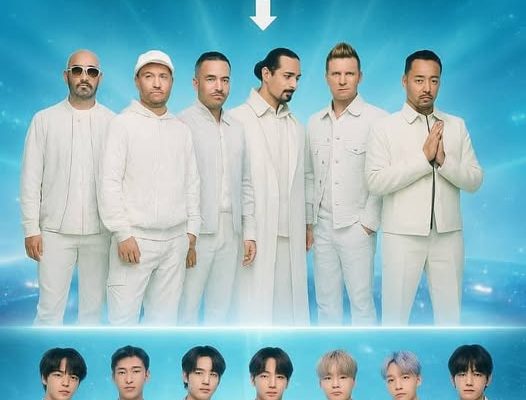In an age where the music industry often feels parsed into meticulously curated algorithms and predictable release schedules, a piece of news has erupted that defies all conventional logic, generational divides, and the very fabric of pop music history. The announcement, which began as a whisper on specialized forums and exploded into a global trending topic within minutes, confirms what many once deemed impossible: BTS and the Backstreet Boys are joining forces for a monumental joint world tour in the summer of 2026. This isn’t a mere co-headlining festival slot or a one-off charity performance; this is “The Harmony Legacy Tour,” a fully integrated, meticulously planned global spectacle promising to merge two distinct eras of pop superstardom into a single, unprecedented live experience.
The initial reaction across social media platforms was a beautiful chaos of disbelief and euphoria. For the ARMY, the fiercely dedicated global fanbase of BTS, the news was met with a wave of shock that quickly morphed into exhilarated curiosity. For the Backstreet Boys’ loyal followers, who have weathered the boy band storms of the late 90s and early 2000s and remained steadfast, the announcement felt like a vindication of their enduring legacy, now being recognized by the biggest musical phenomenon of the 21st century. The collaboration, described in a joint statement from HYBE and Backstreet Boys management as “a celebration of music’s power to connect across time and culture,” seems to have been in secret development for over a year. Insiders suggest that the initial connection was made not by corporate executives, but by the artists themselves, with Jungkook of BTS and Nick Carter of Backstreet Boys reportedly being the primary catalysts, having developed a private friendship based on mutual respect for each other’s craft and performance discipline.
The logistical scale of “The Harmony Legacy Tour” is staggering. It is designed not as two separate sets bookended by a few collaborative songs, but as a fluid, interwoven narrative. The stage design, rumored to be one of the most expensive and technologically advanced ever conceived, will feature a central “nexus” point where the two groups will converge for special collaborative performances. Imagine the possibility of “I Want It That Way” seamlessly transitioning into “Dynamite,” or the iconic five-microphone stand formation of the Backstreet Boys being joined by the seven members of BTS for a powerhouse rendition of “Everybody (Backstreet’s Back).” The potential setlist is a fan’s dreamscape, a puzzle that promises to honor the distinct sonic identities of each group while creating something entirely new. The vocal harmonies that defined a generation with Backstreet Boys are poised to merge with the intricate rap verses, powerful choreography, and genre-bending versatility that BTS has championed.
The revealed dates and cities for 2026 read like a global victory lap, targeting stadiums and arenas capable of housing the expected tidal wave of demand. The tour is scheduled to kick off on June 10th in Seoul, South Korea, at the Gocheok Sky Dome, a symbolic starting point in BTS’s hometown. From there, the tour will traverse Asia with stops in Tokyo’s Tokyo Dome, Bangkok’s Rajamangala National Stadium, and a landmark show at the Philippine Arena in Manila. The North American leg begins in July, launching from the Rose Bowl in Pasadena, California, before moving to major hubs including MetLife Stadium in East Rutherford, New Jersey, Soldier Field in Chicago, and the Rogers Centre in Toronto. European dates in August include London’s Wembley Stadium, Paris’s Stade de France, and a finale in Berlin at the Olympiastadion. Each location was chosen not just for its capacity, but for its historical significance in the respective groups’ touring histories, creating a poignant throughline connecting past and present triumphs.
The cultural implications of this tour are profound. On one hand, you have the Backstreet Boys, the quintessential American boy band whose peak in the late 90s and early 2000s defined an era of pop music. They were a product of a pre-internet, MTV-driven world, where success was measured in CD sales and TRL countdowns. Their harmonies were polished, their dance moves synchronized, and their ballads became the anthems of a generation. On the other hand stands BTS, a South Korean group that rose to global dominance in the social media age. They broke the Western market not through traditional channels, but through YouTube, Twitter, and a digitally connected fandom that operates on a scale never seen before. Their music, while rooted in pop, fearlessly incorporates hip-hop, R&B, EDM, and socially conscious lyrics that often critique the very systems they now top. This tour is more than a concert series; it is a dialogue between two different models of global pop success. It bridges the gap between the manufactured (though no less talented) groups of the old guard and the artist-driven, socially-engaged “idol” system of the new. It’s a passing of the torch, but also a shared carrying of the flame, demonstrating that the core elements of performance, connection, and memorable songwriting are timeless.
Critics and industry analysts are already scrambling to predict the tour’s economic impact, with projections suggesting it will easily become the highest-grossing tour of all time, shattering records previously held by the likes of Elton John and Ed Sheeran. But the true value lies beyond the box office. This is a masterclass in brand expansion and legacy building. For the Backstreet Boys, it introduces their iconic catalog to millions of new, younger listeners, cementing their relevance for decades to come. For BTS, whose members are expected to have completed their mandatory military service by 2025, it represents a triumphant return to the world stage on a scale that dwarfs their previous, already record-breaking, endeavors. It positions them not just as K-pop stars, but as peerless global entertainers sharing a stage with legends.
Of course, the announcement is not without its questions and a palpable sense of anticipation. How will the groups navigate language barriers during live, off-the-cuff moments? The answer likely lies in the universal language of music and performance, and the reported genuine camaraderie developing between the members. Furthermore, what new music might this collaboration inspire? It is almost unthinkable that such a historic partnership would not yield at least one original single, a prospect that has fans speculating wildly about the potential sound—a nostalgic pop banger, a heartfelt ballad, or a genre-defying track that captures the essence of both groups.
In the end, “The Harmony Legacy Tour” is a seismic event that has recalibrated the possibilities within the music industry. It is a testament to the enduring power of the boy band format, redefined for each new generation. It is a story of mutual respect that transcends age, nationality, and the typical boundaries of pop music rivalry. As the summer of 2026 approaches, the world will be watching, waiting to witness a piece of living history. In stadiums across the globe, under the shared lights, the heartfelt crooning of “Show Me The Meaning Of Being Lonely” will meet the hopeful yearning of “Spring Day,” and for a few hours, two distinct worlds will become one, united by the simple, powerful magic of a song. The shock has begun to subside; now, the countdown to a true pop music miracle begins.



